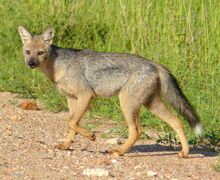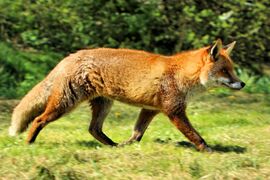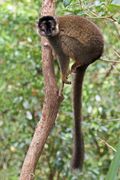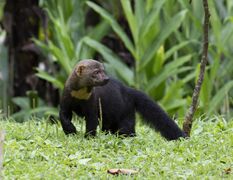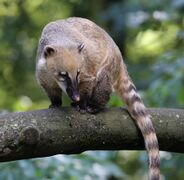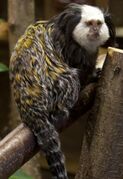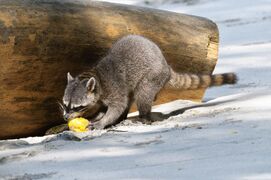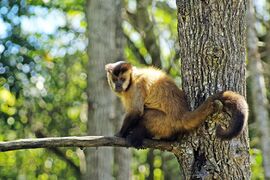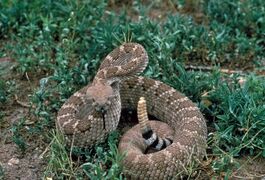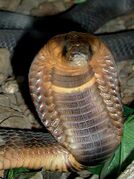Biology:Pachysentis
| Pachysentis | |
|---|---|
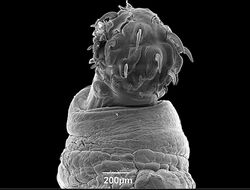
| |
| Proboscis of P. lenti[2] | |
| Scientific classification | |
| Domain: | Eukaryota |
| Kingdom: | Animalia |
| Phylum: | Acanthocephala |
| Class: | Archiacanthocephala |
| Order: | Oligacanthorhynchida |
| Family: | Oligacanthorhynchidae |
| Genus: | Pachysentis Meyer, 1931[1] |
| Type species | |
| Pachysentis canicola Meyer, 1931
| |
| Other species | |
| |
Pachysentis is a genus in Acanthocephala (thorny-headed worms, also known as spiny-headed worms) that parasitize primates and carnivorans. They are distributed across Africa, the Middle East, and the Americas. Pachysentis species attach themselves to the inner lining of the gastrointestinal tract of their hosts using their hook-covered proboscis. Their life cycle includes an egg stage found in host feces, a cystacanth (larval) stage in an intermediate host such as the Egyptian cobra, and an adult stage where cystacanths mature in the intestines of the host. This genus appears identical to the closely related Oncicola apart from a greater number of hooks on the proboscis. There are eleven species assigned to this genus, although P. septemserialis is of uncertain taxonomic status. The female worms range from 12 millimetres (0.47 in) long and 1.6 millimetres (0.063 in) wide in P. lauroi to 50 millimetres (2.0 in) long and 4 millimetres (0.16 in) wide in P. dollfusi. Virtually all of the length is the trunk, with a short proboscis. There is pronounced sexual dimorphism in this species as females are around twice the size of the males.
Taxonomy
Phylogenetic analysis has been conducted on one of the eleven species in the genus, P. canicola, and supporting its independent status in the family Oligacanthorhynchidae.[3] Phylogenetic analyses have also been conducted on Oncicola, a genus morphologically nearly identical to Pachysentis apart from the number of hooks on the proboscis, and have also placed it in the family Oligacanthorhynchidae.[4] The type species for Pachysentis is P. canicola.[5][2] In 1972, Schmidt reclassified six species from the Prosthenorchis genus and one species from the Oncicola genus into the genus Pachysentis.[6]
| Archiacanthocephala | ||||||||||||||||||||||||||||||||||||
| ||||||||||||||||||||||||||||||||||||
| Phylogenetic reconstruction for select species in the class Archiacanthocephala based on a 28S rRNA gene comparison from Gomes et. al (2019) and a 18S rDNA gene comparison from Amin and colleagues (2020).[2][7] Amin and colleagues (2022) used the 18S rDNA gene and ITS1-5.8-ITS2 region of ribosomal RNA comparisons to add P. canicola phylogenetically to the family Oligacanthorhynchidae.[3] |
Description
| Number of proboscis hooks[2] | Barbs in hooks | |
|---|---|---|
| P. angolensis | 42 | No barbs |
| P. canicola | 72 | No barbs |
| P. dollfusi | 48 | Barbs |
| P. ehrenbergi | 102 | Barbs[lower-alpha 1] |
| P. gethi | 42 | No barbs |
| P. lauroi | 48 | Barbs |
| P. lenti | 48 | No barbs |
| P. procumbens | 90 | No barbs |
| P. procyonis | 42 | No barbs |
| P. rugosus | 42 | No barbs |
Pachysentis looks identical to the closely related Oncicola apart from the number of hooks on the proboscis. Species of Oncicola have 36 or fewer hooks whereas species of Pachysentis have more. The probosces of Pachysentis species are not quite spherical and contain 42 to 102 hooks arranged into 12 longitudinal rows of 3 to 12 hooks each. Depending on the species, the rows may be regularly or irregularly alternating and straight or crooked. Hooks have tips with or without barbs, and the larger hooks with complex heads (manubria) and roots with the remaining spines being rootless. The trunk is fairly wide relative to the length with the anterior half usually wider than the posterior half. The testes are in tandem with at least one located before the middle of the worm. There are eight cement glands compactly arranged each with a single giant nucleus used to temporarily close the posterior end of the female after copulation.[8][9] The eggs have a sculptured outer membrane. Species can be distinguished based on the number and arrangements of proboscis hooks, whether these hooks are barbed, the arrangement of the cement glands, host, and the length of lemnisci.[2]
| Female measurements (mm)[2] | |||||||||||
|---|---|---|---|---|---|---|---|---|---|---|---|
| Measurements[lower-alpha 2] | P. angolensis | P. canicola | P. dollfusi | P. ehrenbergi | P. gethi | P. lauroi | P. lenti | P. procumbens[lower-alpha 3] | P. procyonis | P. rugosus | |
| Length of proboscis | 0.55-0.63 | 0.57-0.80 | ? | 0.8 | 0.583 | 0.68 | 0.63 | 0.55 | 0.697 | 0.564 | |
| Width of proboscis | 0.70–0.82 | 0.57–0.85 | ? | 0.9 | 0.794 | 0.76 | 0.664 | 0.55 | 0.716 | 0.694 | |
| Length of proboscis receptacle | 1.5 | 2 | ? | 1.3 | 1.07 | 1.16 | 1.32 | 1.2 | 1.37 | 1.24 | |
| Width of proboscis receptacle | ? | ? | ? | ? | 0.498 | 0.47 | ? | ? | 0.531 | 0.481 | |
| Length of trunk | 34–48 | 20–26 | 50 | 26–29 | 15–25 | 12.07 | 20–25 | 6 | 25-35 | 32 | |
| Width of trunk | 4.8–5.5 | 5-11 | 4 | 6 | 1.5–3 | 1.62 | 2–2.5 | 1.25 | 2–3 | 3 | |
| Length of lemnisci | 5.8–6 | 7 | 4.3–6.6 | 7 | 3.48 | 4.45 | 3.15 | ? | 3.64 | 4.64 | |
| Width of lemnisci | ? | ? | ? | 0.8 | ? | ? | ? | ? | ? | ? | |
| Uterine bell | ? | 3.15–8.15 | ? | ? | 5.56 | 1.19 | 1.41 | ? | 4.64 | 5.86 | |
| Size of eggs | 0.09 × 0.043 | 0.07 × 0.045 | 0.08 × 0.05 | 0.07 × 0.05 | 0.084 × 0.054 | 0.073 × 0.045 | ? | ? | 0.071 × 0.042 | ? | |
| Male measurements (mm)[2] | |||||||||||
| Length of proboscis | 0.55-0.63 | 0.57-0.80 | ? | 0.8 | 0.583 | 0.68 | 0.63 | 0.55 | 0.697 | 0.564 | |
| Width of proboscis | 0.70–0.82 | 0.57–0.85 | ? | 0.9 | 0.794 | 0.76 | 0.664 | 0.55 | 0.716 | 0.694 | |
| Length of proboscis receptacle | 1.5 | 2 | ? | 1.3 | 1.07 | 1.16 | 1.32 | 1.2 | 1.37 | 1.24 | |
| Width of proboscis receptacle | ? | ? | ? | ? | 0.498 | 0.47 | ? | ? | 0.531 | 0.481 | |
| Length of trunk | 17-23 | 15-28 | 50 | 25 | 10–15 × 1.0–2.5 | 9.63 | 15–20 | 6 | 20-30 | 25 | |
| Width of trunk | 3.5–4 | 4-8 | 4 | 4 | 1.0–2.5 | 1.91 | 1.0–2.5 | 1.25 | 2–3 | 3.5 | |
| Length of lemnisci | 5.8–6 | 7 | 4.3–6.6 | 7 | 3.48 | 4.45 | 3.15 | ? | 3.64 | 4.64 | |
| Width of lemnisci | ? | ? | ? | 0.8 | ? | ? | ? | ? | ? | ? | |
| Size of anterior testis | 2–3 × 0.9 | 2 | ? | 3 | 1.40 × 0.581 | 1.15 × 0.48 | 1.76 × 0.51 | ? | 3.01 × 1.24 | 1.57 × 0.697 | |
| Size of posterior testis | 2–4.3 × 1.0 | 2 | ? | 3 | 1.40 × 0.581 | 1.27 × 0.55 | 1.82 × 0.547 | ? | 3.15 × 1.07 | 1.69 × 0.664 | |
| Dimension of group of cement gland | 3 | 3 | ? | 7 | 1.54 | 0.86 × 0.56 | 2.98 | ? | 3.56 | 2.02 | |
| Ejaculatory duct length | 2.3 | ? | ? | ? | 4.64 | 1.42 | ? | ? | 3.53 | 1.68 | |
Species
The genus Pachysentis Meyer, 1931 contains eleven species, although P. septemserialis is of uncertain taxonomic status.[2][10][lower-alpha 4]
- Pachysentis angolensis (Golvan, 1957)[11][lower-alpha 5]
P. angolensis was found infesting the side-striped jackal (Canis adustus). The proboscis has a total of 42 hooks without barbs in 12 regularly alternating rows of three and four hooks (six rows of each).[11] The eight cement glands are organized in pairs.[2] This species is named after Angola, the country where it was first discovered.[11]
- Pachysentis canicola Meyer, 1931[1]
P. canicola was found infesting the red fox (Vulpes vulpes) in Bushehr, Bushehr Province, Iran,[12] the golden jackal (Canis aureus) also in Iran,[13] the maned wolf (Chrysocyon brachyurus) in Texas , and the striped skunk (Mephitis mephitis), also in Texas.[3] It was also found infesting the western diamondback rattlesnake (Crotalus atrox).[14][15] It is the type species of the genus Pachysentis.[1] The species name canicola is derived from the Latin word for canine which is the type of creature (family Canidae) that this species infests.[1]
- Pachysentis dollfusi (Machado-Filho, 1950)[16][lower-alpha 6]
P. dollfusi was found infesting the intestines of the common brown lemur (Eulemur fulvus) in a Brazilian zoo but originally from the island of Madagascar .[16] It is thus unknown if the worm originates from Brazil or Madagascar.[2] The proboscis has 48 barbed hooks arranged into six rows of four hooks each followed by another six rows of four hooks each. The cement glands are in uniform pairs.[2] It is synonymous with Prosthenorchis spirula Travassos 1917.[17] It is named after the parasitologist Robert-Philippe Dollfus.[16]
- Pachysentis ehrenbergi Meyer, 1931[1]
P. ehrenbergi was found infesting the red fox (Vulpes vulpes) in Egypt and in an intermediate host, the Egyptian cobra (Naja haje). The proboscis is armed with 102 barbed hooks arranged into six rows of nine each followed by six rows of eight hooks each.[2] P. ehrenbergi was reported infesting the body cavity of 5.4% of a sample of African five-lined skinks (Trachylepis quinquetaeniata) in the Qena Governorate of Egypt, however the measurements and morphological description do not match either the original description by Meyer in 1931[1] or the reexamination of original specimens by Gomes and colleagues in 2019.[2] Juvenile P. ehrenbergi have been reported infesting the long-eared hedgehog (Hemiechinus auritus) in the Faran Oasis, South Sinai, Egypt. Juvenile trunk length is reported to be 3.22–4.16 mm by 0.87–1.04 mm, the proboscis length to be 0.42–0.60 mm in length by 0.45–0.68 mm in width, the proboscis sheath to be 0.79–1.0 mm by 0.37–0.52 mm (whereas the measurements given by Meyer in the original 1931 description is larger, at 1.3 mm in length and the proboscis measuring 0.8 mm in length by 0.9 mm in width). The anterior proboscis hooks in the juveniles are reported to be large, from 0.078–0.086 mm long, and the posterior hooks smaller, from 0.052–0.062 mm.[18]
- Pachysentis gethi (Machado-Filho, 1950)[16][lower-alpha 7]
P. gethi was originally described in 1950 by Machado-Filho infesting tayra (Eira barbara) in Pará and Rio de Janeiro, Brazil but this remained the only record until it was rediscovered in 2016 infesting the wild lesser grison (Galictis cuja), also in Rio de Janeiro, with different measurements.[19] The proboscis has 42 hooks without barbs arranged into six rows of four hooks followed by six rows of three hooks. The eight cement glands occur in pairs.[2] The species is named after Dr. Geth Jansen.[16]
- Pachysentis lauroi Gomes, Amin, Olifiers, Bianchi, Souza, Barbosa & Maldonado, 2019[2]
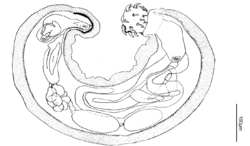
P. lauroi has been found infesting the South American coati (Nasua nasua) in Mato Grosso do Sul, Brazil. The proboscis has 48 barbed hooks arranged into six rows of four hooks followed by six rows of four hooks. The eight cement glands are clustered. It was found in the small intestine.[2] The species is named after Lauro Travassos (pt), a parasitologist who studied Brazilian Acanthocephala.[2]
- Pachysentis lenti (Machado-Filho, 1950)[16][lower-alpha 8]
P. lenti has been found infesting the white-headed marmoset (Callithrix geoffroyi) in Espirito Santo, Brazil. The proboscis has 48 hooks without barbs arranged into six rows of four hooks followed by six rows of four hooks.[2] It is named after Herman Lent (pt), a Brazilian parasitologist.[16]
- Pachysentis procumbens Meyer, 1931[1]
P. procumbens has been found infesting the red fox (Vulpes vulpes) in Argo, Egypt. The proboscis has 90 hooks without barbs arranged into six rows of seven hooks followed by six rows of eight hooks. [2] The species name is from the Latin procumbent, meaning "lying prostrate".[20]
- Pachysentis procyonis (Machado-Filho, 1950)[16][lower-alpha 9]
P. procyonis was found infesting the intestines of a crab-eating raccoon (Procyon cancrivorus) in Rio de Janeiro, Brazil.[21] The proboscis has 42 hooks without barbs arranged into six rows of four hooks followed by six rows of three hooks. Distinguishing features include eight clustered cement glands and very short lemnisci that do not reach the anterior testis.[2] The species is named after the genus of the host (Procyon) it was found infesting.[16] It is the only known parasite of the crab-eating racoon in Brazil.[22]
- Pachysentis rugosus (Machado-Filho, 1950)[16][lower-alpha 10]
P. rugosus has been found to infest the large intestine of Azaras's capuchin (Sapajus cay) in Rio de Janeiro, Brazil, and the tufted capuchin (Sapajus apella), also in Brazil.[23] The proboscis is armed with 42 hooks without barbs arranged into six rows of four hooks each followed by six rows of three hooks each. This species can be identified by its clustered cement glands and long leminisci that reach the anterior testis. [2] The species name rugosus is Latin for 'wrinkled'.
- Pachysentis septemserialis (Machado-Filho, 1950)[16][lower-alpha 11]
P. septemserialis is considered by Gomes (2019) to have an uncertain taxonomic status due to differences between the paratypes morphological characteristics and the original description, the similarity in hosts (primates of the family Callitrichidae including the black tamarin (Saguinus niger),[24] and the absence of samples or measurements of adult males. Specifically, the original description of one paratype described the lack of a collar at the base of the proboscis whereas a collar was observed (suggesting affiliation with the genus Prosthenorchis). A second discrepancy from another paratype is the incorrect number of hooks; 12 longitudinal rows of four hooks with total of 48 hooks were observed but contradicts the seven rows of seven hooks with a total of 49 hooks given in the original description. The name septemserialis refers to the seven rows in series.[16] Morphologically, new observations suggest it is synonymous with P. lenti.[2]
Distribution
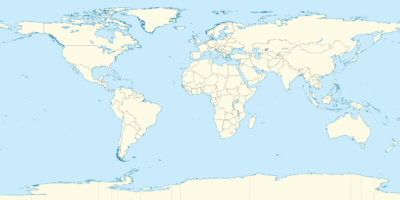
The distribution of Pachysentis species is determined by that of its hosts. Pachysentis species have been found in North America (Texas), South America (Brazil), Africa (Egypt and Angola), Asia (Egypt and Iran).[2]
Hosts

The life cycle of an acanthocephalan consists of three stages beginning when an infective acanthor (development of an egg) is released from the intestines of the definitive host and then ingested by an arthropod, the intermediate host. The intermediate hosts of most Pachysentis species are not known. When the acanthor molts, the second stage called the acanthella begins. This stage involves penetrating the wall of the mesenteron or the intestine of the intermediate host and growing. The final stage is the infective cystacanth which is the larval or juvenile state of an Acanthocephalan, differing from the adult only in size and stage of sexual development. The cystacanths within the intermediate hosts are consumed by the definitive host, usually attaching to the walls of the intestines, and as adults they reproduce sexually in the intestines. The acanthor are passed in the feces of the definitive host and the cycle repeats.[27]
Pachysentis species exclusively parasitize primates and carnivorans as their primary host.[2] Paratenic hosts (hosts where parasites infest but do not undergo larval development or sexual reproduction) for Pachysentis have been found for P. ehrenbergi (Egyptian cobra, Naja haje)[18] and P. canicola (western diamondback rattlesnake, Crotalus atrox).[15] There are no reported cases of any Pachysentis species infesting humans in the English language medical literature.[26]
- Hosts for Pachysentis species
-
The side-striped jackal is one of the hosts of P. angolensis
-
The red fox is one of the hosts of P. canicola and P. procumbens
-
The common brown lemur is one of the hosts of P. dollfusi
-
The tayra is one of the hosts of P. gethi
-
The South American coati is one of the hosts of P. louroi
-
The white-headed marmoset is one of the hosts of P. lenti
-
The crab-eating raccoon is one of the hosts of P. procyonis
-
The Azaras's capuchin is one of the hosts of P. rugosus
-
The western diamondback rattlesnake is a paratenic host of P. canicola
-
The Egyptian cobra is a paratenic host of P. ehrenbergi
Notes
- ↑ Barbs were not mentioned in the original description of the species by Meyer (1931),[1] but were found in the 2019 reexamination of the original samples in 2019 by Gomes.[2]
- ↑ One value for the length and width of the proboscis, size of proboscis receptacle, and length of lemnisci is reported for both sexes in all species.
- ↑ Measurements are from a juvenile P. procumbens and one value for all measurements is given for both sexes.
- ↑ A binomial authority in parentheses indicates that the species was originally described in a genus other than the present genus.
- ↑ P. angolensis was originally named Oncicola angolensis by Golvan in 1957 but was renamed by Schmidt in 1972.[6][5]
- ↑ P. dollfusi was originally named Prosthenorchis dollfusi by Machado-Filho in 1950 but was renamed by Schmidt in 1972.[6][5]
- ↑ P. gethi was originally named Prosthenorchis gethi by Machado-Filho in 1950 but was renamed by Schmidt in 1972.[6][5]
- ↑ P. lenti was originally named Prosthenorchis lenti by Machado-Filho in 1950 but was renamed by Schmidt in 1972.[6][5]
- ↑ P. procyonis was originally named Prosthenorchis procyonis by Machado-Filho in 1950 but was renamed by Schmidt in 1972.[6][5]
- ↑ P. rugosus was originally named Prosthenorchis rugosus by Machado-Filho in 1950 but was renamed by Schmidt in 1972.[6][5]
- ↑ P. septemserialis was originally named Prosthenorchis septemserialis by Machado-Filho in 1950 but was renamed by Schmidt in 1972.[6][5]
- ↑ There are no known aberrant human infections for Pachysentis species.[26]
References
- ↑ 1.0 1.1 1.2 1.3 1.4 1.5 1.6 1.7 Meyer, A (1931). "Neue Acanthocephalen aus dem Berliner Museum. Burgrundung eines neue Acanthocephalen systems auf Grund einer Untersuchung der Berliner Sammlung" (in de). Zoologische Jahrbücher, Abteilung für Systematik, Ökologie und Geographie der Tiere 62: 53–108.
- ↑ 2.00 2.01 2.02 2.03 2.04 2.05 2.06 2.07 2.08 2.09 2.10 2.11 2.12 2.13 2.14 2.15 2.16 2.17 2.18 2.19 2.20 2.21 2.22 2.23 2.24 2.25 2.26 Gomes, Ana Paula N.; Amin, Omar M.; Olifiers, Natalie; Bianchi, Rita de Cassia; Souza, Joyce G. R.; Barbosa, Helene S.; Maldonado, Arnaldo (2019). "A New Species of Pachysentis Meyer, 1931 (Acanthocephala: Oligacanthorhynchidae) in the Brown-Nosed Coati Nasua nasua (Carnivora: Procyonidae) from Brazil, with Notes on the Genus and a Key to Species". Acta Parasitologica 64 (3): 587–595. doi:10.2478/s11686-019-00080-6. PMID 31286360.
- ↑ 3.0 3.1 3.2 Amin, Omar M.; Chaudhary, Anshu; Heckmann, Richard A.; Swenson, Julie; Singh, Hridaya S. (2022-03-01). "Redescription and Molecular Characterization of Pachysentis canicola Meyer, 1931 (Acanthocephala: Oligacanthorhynchidae) from the Maned Wolf, Chrysocyon brachyurus (Illiger, 1815) in Texas" (in en). Acta Parasitologica 67 (1): 275–287. doi:10.1007/s11686-021-00458-5. PMID 34345996. https://doi.org/10.1007/s11686-021-00458-5. Retrieved 28 December 2022.
- ↑ Nascimento Gomes, Ana Paula; Cesário, Clarice Silva; Olifiers, Natalie; de Cassia Bianchi, Rita; Maldonado, Arnaldo; Vilela, Roberto do Val (December 2019). "New morphological and genetic data of Gigantorhynchus echinodiscus (Diesing, 1851) (Acanthocephala: Archiacanthocephala) in the giant anteater Myrmecophaga tridactyla Linnaeus, 1758 (Pilosa: Myrmecophagidae)". International Journal for Parasitology: Parasites and Wildlife 10: 281–288. doi:10.1016/j.ijppaw.2019.09.008. PMID 31867208.
- ↑ 5.0 5.1 5.2 5.3 5.4 5.5 5.6 5.7 Amin, Omar M. (September 19, 2013). "Classification of the Acanthocephala". Folia Parasitologica 60 (4): 273–305. doi:10.14411/fp.2013.031. PMID 24261131.
- ↑ 6.0 6.1 6.2 6.3 6.4 6.5 6.6 6.7 Schmidt, G. D. (1972). "Revision of the class Archiacanthocephala Meyer, 1931 (phylum Acanthocephala), with emphasis on Oligacanthorhynchidae Southwell et Macfie, 1925". The Journal of Parasitology 58 (2): 290–297. doi:10.2307/3278091. PMID 5022866.
- ↑ Amin, O.M.; Sharifdini, M.; Heckmann, R.A.; Zarean, M. (2020). "New perspectives on Nephridiacanthus major (Acanthocephala: Oligacanthorhynchidae) collected from hedgehogs in Iran". Journal of Helminthology 94: e133. doi:10.1017/S0022149X20000073. PMID 32114988.
- ↑ Bush, Albert O.; Fernández, Jacqueline C.; Esch, Gerald W.; Seed, J. Richard (2001). Parasitism: the diversity and ecology of animal parasites. Cambridge, UK New York, NY: Cambridge University Press. p. 203. ISBN 0-521-66278-8. OCLC 44131774.
- ↑ Kükenthal, W (2014). Gastrotricha and Gnathifera. Göttingen, Germany: Walter de Gruyter. p. 322. ISBN 978-3110274271. https://books.google.com/books?id=hwCTBgAAQBAJ&q=K%C3%BCkenthal,+W.+(2014).+Gastrotricha+and+Gnathifera.+Walter+de+Gruyter+GmbH+and+Co+KG.&pg=PP11. Retrieved 3 August 2021.
- ↑ "Oligacanthorhynchidae Petrochenko, 1956". May 20, 2020. https://www.itis.gov/servlet/SingleRpt/SingleRpt?search_topic=TSN&search_value=196612.
- ↑ 11.0 11.1 11.2 Golvan, Y. J. (1957). "Acanthocephales de l'Angola. I. Oncicola angolensis n. sp.(Archiacanthocephala-Pachysentidae), parasite du Chacal, Canis adustus Sundevall" (in fr). Publicacion Servicos Culturais de la Companhia de Diamantes de Angola. Meseu Dundo Lunda. 34: 39–50.
- ↑ Tavakol, Sareh; Amin, Omar M.; Luus-Powell, Wilmien J.; Halajian, Ali (22 October 2015). "The acanthocephalan fauna of Iran, a check list". Zootaxa 4033 (2): 237–258. doi:10.11646/zootaxa.4033.2.3. PMID 26624401.
- ↑ Gherman, Călin Mircea; Mihalca, Andrei Daniel (2017). "A synoptic overview of golden jackal parasites reveals high diversity of species". Parasites & Vectors 10 (1): 419. doi:10.1186/s13071-017-2329-8. PMID 28915831.
- ↑ Bolette, David P. (August 1997). "First Record of Pachysentis canicola (Acanthocephala: Oligacanthorhynchida) and the Occurrence of Mesocestoides sp. Tetrathyridia (Cestoidea: Cyclophyllidea) in the Western Diamondback Rattlesnake, Crotalus atrox (Serpentes: Viperidae)". The Journal of Parasitology 83 (4): 751–752. doi:10.2307/3284256. PMID 9267421.
- ↑ 15.0 15.1 Carbajal-Márquez, Rubén Alonso; González-Solís, David; Cedeño-Vázquez, J. Rogelio (2018). "Endoparasites of Crotalus tzabcan (Serpentes: Viperidae), with a checklist in rattlesnakes". Journal of Parasitic Diseases 42 (2): 303–314. doi:10.1007/s12639-018-1001-3. PMID 29844637.
- ↑ 16.00 16.01 16.02 16.03 16.04 16.05 16.06 16.07 16.08 16.09 16.10 16.11 Machado-Filho, D.A. (1950). "Revisão do gênero Prosthenorchis Travassos, 1915 (Acanthocephala)" (in pt). Memórias do Instituto Oswaldo Cruz 48: 495–545. doi:10.1590/S0074-02761950000100020. PMID 24539413. https://www.scielo.br/j/mioc/a/BG9rPrJjXvJp9Q8ddGtPM4w/?format=pdf&lang=pt.
- ↑ Golvan, Y. J. (1962). "Le phylum des Acanthocephala.(Quatrieme note). La classe des Archiacanthocephala (A. Meyer 1931)" (in fr). Annales de Parasitologie Humaine et Comparée 37 (1–2): 1–72. https://www.parasite-journal.org/articles/parasite/pdf/1962/01/parasite1962371p1.pdf.
- ↑ 18.0 18.1 Nelson, D. R.; Ward, H. L. (1966). "Acanthocephala from hedgehogs in Egypt". Journal of the Tennessee Academy of Science 41 (3): 101–105. https://www.tennacadofsci.org/journal/articles/vol41/JTAS41-3-101.pdf. Retrieved March 21, 2023.
- ↑ Muniz-Pereira, Luís C.; Corrêa, Pilar; Bueno, Cecília; Vieira, Fabiano M. (2016). "Rediscovery of Pachysentis gethi (Acanthocephala: Oligacanthorhynchidae), a parasite of wild lesser grison Galictis cuja (Carnivora: Mustelidae) from Brazil". Revista Mexicana de Biodiversidad 87 (4): 1356–1359. doi:10.1016/j.rmb.2016.10.010.
- ↑ Onions, C. T. (1972). The Shorter Oxford English Dictionary (3rd (rev.) ed.). Oxford: Oxford at the Clarendon Press. pp. 1591.
- ↑ Silva, P. C. D. (2015). Estudo da Helmintofauna de Galictis cuja (Molina, 1872) (Carnivora, Mustelidae) atropelados na rodovia BR-040, no trecho entre Rio de Janeiro, RJ e Juiz de Fora, MG (Thesis). Rio de Janeiro: Instituto Oswaldo Cruz. Archived from the original on 9 July 2023. Retrieved 9 July 2023.
- ↑ Oliveira, Wilson Junior; Santos, Andre Luiz Quagliatto; Souza, Wilson Viotto de; Custódio, Ana Elizabeth Iannini; Lux-Hoppe, Estevam Guilherme; Rosalinski-Moraes, Fernanda (2019). "Oncicola luehei in a wild crab-eating raccoon (Procyon cancrivorus) from the Brazilian cerrado savanna". Revista de Patologia Tropical 48 (4): 243–248. doi:10.5216/rpt.v48i4.61278. https://revistas.ufg.br/iptsp/article/view/61278. Retrieved 9 July 2023.
- ↑ Corrêa, Pilar; Bueno, Cecília; Soares, Rita; Vieira, Fabiano M.; Muniz-Pereira, Luís C. (2016). "Checklist of helminth parasites of wild primates from Brazil". Revista Mexicana de Biodiversidad 87 (3): 908–918. doi:10.1016/j.rmb.2016.03.008.
- ↑ Solórzano-García, B., de León, G. P. P., Table, S. I., & Amoebozoa, P. Electronic Supplementary Material Parasites of Neotropical Primates: A Review.
- ↑ CDC’s Division of Parasitic Diseases and Malaria (April 11, 2019). "Acanthocephaliasis". Center for Disease Control. https://www.cdc.gov/dpdx/acanthocephaliasis/index.html.
- ↑ 26.0 26.1 Mathison, BA (2021). "Human Acanthocephaliasis: a Thorn in the Side of Parasite Diagnostics". J Clin Microbiol 59 (11): e02691-20. doi:10.1128/JCM.02691-20. PMID 34076470. PMC 8525584. https://doi.org/10.1128%2FJCM.02691-20.
- ↑ Schmidt, G.D. (1985). "Development and life cycles". Biology of the Acanthocephala. Cambridge: Cambridge Univ. Press. pp. 273–305. https://core.ac.uk/download/pdf/17218255.pdf. Retrieved 17 July 2023.
Wikidata ☰ Q3825715 entry
 |
